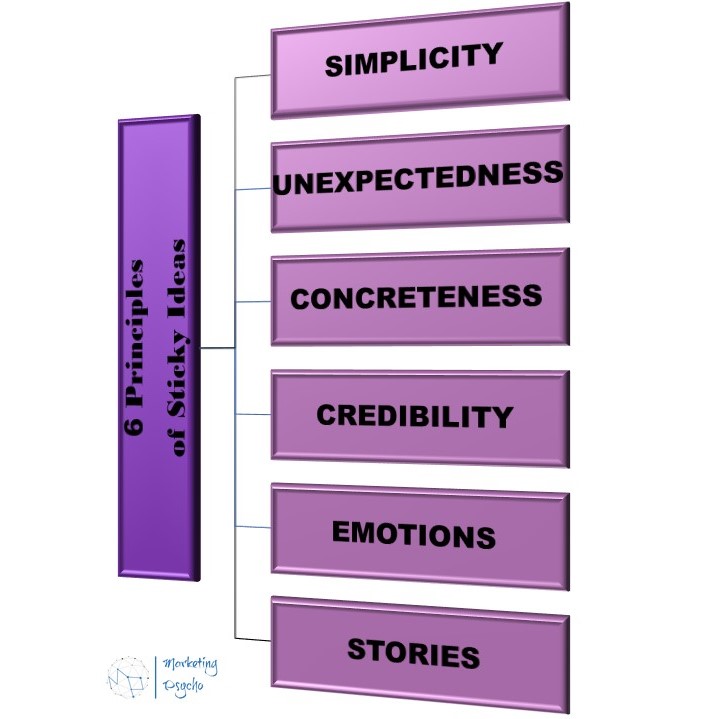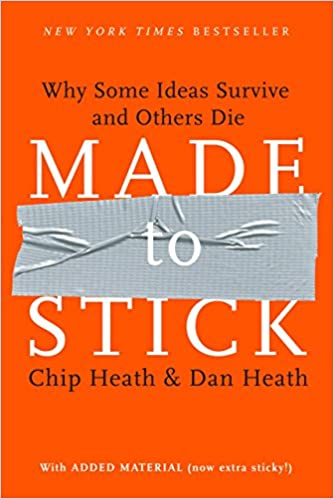An idea that can penetrate people’s hearts, stay in their memory, change their behavior is a truly HUGE IDEA. But what makes some ideas popular and so successful, and others, although they may be more truthful, are not viable? And how do you still make your ideas work? In their book Made to Stick: Why Some Ideas Survive and Others Die Chip Heath and Dan Heath, based on their experience and research, have tried to give answers to these questions.
Of course, there is no universal formula for creating sticky ideas that could solve your problems once and for all, just as there is no one cure for all diseases. It is known that people have many common features, at the same time, no one should forget that each of us is individual. Nevertheless, the authors studied a large number of different sources with influential ideas that have been in people’s minds for a long time, such as proverbs, urban legends, conspiracy theories, wartime rumors, jokes, and others, and tried to highlight the main characteristics that unite them. They called them the six principles of sticky ideas.
Six Principles of Sticky Ideas

If you look closely, then from these six words, you can form the acronym SUCCESs. In this case, it will be easier for you to remember the checklist for a successful idea: a Simple Unexpected Concrete Credentialed Emotional Story. So, what does the SUCCESs formula mean? Chip Heath and Dan Heath have dedicated a separate chapter to each principle to describe the mechanism of operation in more detail.
PRINCIPLE 1: SIMPLICITY
The Golden Rule is the ultimate model of simplicity: a one-sentence statement so profound that an individual could spend a lifetime learning to follow it. Saying something short is not a mistake. The authors propose the following formula to explain what simplicity is in this situation:
Simple = Core + Compact
You must first find the core of the message and then share the core. Core messages remind people of what’s important. With the help of a well-chosen essence, such ideas acquire depth. Compact is also important because there is a limit to the amount of information we can remember at the same time.
In some cases, to create simple but sticky messages, you’d better replace something difficult to think about with something easy. To do this, you will need to know the schemes that people usually use when thinking, as well as learn how to use analogies. Analogies allow you to understand a compact message because they correspond to concepts that you already know.
PRINCIPLE 2: UNEXPECTEDNESS
For the idea to go viral, we need to break people’s expectations.
There are two important points:
1- GETTING PEOPLE’S ATTENTION. First of all, we have to excite people with our ideas, we have to stand out from the array in some way. The easiest way is to break the pattern. The main emotion here is a surprise. People adapt incredibly quickly to consistent patterns. But this is not enough for the idea to remain viable, it is also necessary to keep attention.
2- KEEPING PEOPLE’S ATTENTION. Another emotion comes into play here – interest. Do not open all the cards at once, intrigue your audience. First, provide some of the information so that they get into the course of the case, and then, portion by portion, discover new knowledge for them.
PRINCIPLE 3: CONCRETENESS
You should avoid ambiguity in your messages. Sometimes the same phrase sounds different to two different people because each of them understands it in their way. Speaking concretely is the only way to make sure that our idea will mean the same thing to everyone in our audience. When people understand each other, it is easier for them to cooperate, they find a common language. Specific ideas are also easier to remember. We don’t think in abstract things but in concrete images. To make our idea more concrete, we must clearly understand who our audience is, who our message is aimed at, and what their needs are.
PRINCIPLE 4: CREDIBILITY
Credibility is a shaky ground. It is necessary to be very careful when entering this territory. It is often difficult for people to open up and trust someone or something. Another difficult side is that if you undermine the trust once placed in you, it is almost impossible to get it back. Therefore, take care of your messages and your attitude towards people.
Chip Heath and Dan Heath identify three areas of credibility creation that you can work with to make sticky ideas:
- External sources. These are authorities, such as experts and celebrities, and antiauthorities.
- Sources inside the message itself. These are details, statistics, and examples.
- Testable credentials. This method allows participants to try it themselves, and who can we trust more than ourselves.
PRINCIPLE 5: EMOTIONS
People may believe you, but they will not go further, they will not cross a certain line. For them to take action, they must care. And how can we get people to care about our messages? We should not invent anything new, we just need to use the means that we already have. In our case, these are emotions. We don’t create new ones, we focus on existing ones.
Chip Heath and Dan Heath suggest several ways to work with emotions:
- Power of Association. The authors talk about such a phenomenon as Semantic Stretch. The Semantic Stretch is the use of terms and concepts for their emotional response. Some words are used first with one purpose and cause a number of emotions, and then their meanings begin to stretch and are used for their own purposes. The tactics of associations are based on the formation of a connection between what people still care about and what they really care about.
- Self-interest. We force people to take care by addressing the things that are important to them. But that’s not all. Chip Heath and Dan Heath tried to get out of the narrow understanding of personal interest, which is limited only to wealth and security. To do this, they used the theory of the American psychologist Abraham Maslow, which is called Maslow’s Pyramid, or Maslow’s Hierarchy of Needs. He identified the following needs and desires that people are trying to satisfy: Physical, Security, Belonging, Esteem, Learning, Aesthetic, Self-actualization, and Transcendence. The idea is that people’s most basic needs must be met before they become motivated to achieve higher-level needs. Subsequent studies show that the hierarchical aspect of Maslow’s theory is questionable since people satisfy all these needs almost simultaneously. Therefore, the authors believe that it is worth paying attention to all aspects of people’s desires and not to miss many opportunities to motivate them.
- Identity. We must appeal not only to people’s personal interests but also to their personality, that is, not only to the people they are now but also to the people they would like to be. The person must answer the following questions: Who am I? What kind of situation is this? And what do people like me do in this kind of situation?
PRINCIPLE 6: STORIES
Stories help to blur the lines between the real and fictional world, between the listener and the main character. When people listen to or read a story, they immerse themselves in the author’s world, empathize with the characters, and mentally model situations. Mental modeling prepares them internally for action if the need arises.
Storytelling helps to convey your idea and not meet fierce resistance. If you tell people directly whether to think or do something in a certain way, then it is unlikely that you will succeed. It is necessary for people to come to a conclusion themselves, then it is easier for them to accept your idea, so they will consider it almost their own. With the help of a story, you engage the audience — you involve people in the idea, asking them to participate with you.
The authors analyzed a number of inspiring stories and identified three main plots in them: the Challenge plot, the Connection plot, and the Creativity plot.
Storytelling Plots
THE CHALLENGE PLOT
The main character overcomes a difficult task and succeeds. These are options such as the underdog story, the rags to riches story, the triumph of sheer willpower over adversity. A key element of the Challenge plot is that the obstacles seem intimidating to the main character. The Challenge plot makes us want to work harder, solve new tasks, overcome obstacles, they inspire us to take action.
THE CONNECTION PLOT
This is a story about people who develop relationships that bridge the gap – racial, class, ethnic, religious, demographic, or otherwise. The Connection plot is also great for romantic stories. The Connection plot inspires us socially. They make us want to help others, be more tolerant of others, work with others, love others.
THE CREATIVITY PLOT
The Creativity plot assumes that someone makes a mental breakthrough, unravels some puzzle, or solves a problem in an innovative way. The Creativity plot makes us want to do something different, be creative, experiment with new approaches.
You don’t have to invent new stories to promote your goal, it’s enough to learn how to identify stories that have potential and be able to use them at the right time and with the right purpose. Make sure that the story reflects exactly your message, otherwise even the most inspiring story will not make sense to you.
At first glance, everything is simple, the path is indicated first and to the end, so why don’t sticky ideas come crashing down on us from all sides, although we see many attempts, few of them achieve the goal. There is a certain BUT in the SUCCESs formula, which should not be forgotten throughout the creation of an attractive idea.
Chip Heath and Dan Heath call this phenomenon the Curse of Knowledge. The Curse of Knowledge is a natural psychological tendency that constantly undermines our ability to create sticky ideas using these principles. Once we know something, it’s hard for us to imagine what it’s like not to know it. And it becomes difficult for us to share our knowledge with others because we cannot easily recreate the state of mind of our listeners. You can’t unlearn what you already know. The authors believe that there are only two ways to fight this enemy: the first is to learn nothing and the second is to take your sticky ideas and transform them.
At the end of the book Made to Stick: Why Some Ideas Survive and Others Die, Chip Heath and Dan Heath offer another version of the structure to make the idea useful and durable. It looks like this:
- Pay attention
- Understand and remember it
- Agree/Believe
- Care
- Be able to act on it
If we look at these five steps in more detail, we can see that they all reflect the SUCCESs formula.
- Pay attention: UNEXPECTED
- Understand and remember it: CONCRETE
- Agree/Believe: CREDIBLE
- Care: EMOTIONAL
- Be able to act on it: STORY
The item “Simplicity” is missing from the above list because it is mainly about the stage of honing the core of your message and making it as compact as possible. But simple messages help throughout the process, especially helping people understand and act.
The authors purposely did not build the narrative of the book around the above structure to avoid the trap of the Curse of Knowledge. The principles of sticky ideas are equivalent to replacing these steps, and they are more tangible and less subject to the Curse of Knowledge. Thus, the SUCCESs checklist is an ideal tool for solving communication problems.
Find more marketing, management, sales, branding, and business books’ reviews in Book Reviews section of my marketing blog.
If you want a monthly update about marketing and sales delivered to your e-mail address, please, subscribe to Marketing Psycho Marketing and Sales newsletter.





